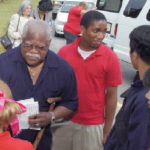By WILL LESTER, Associated Press
As the pennant races head into the fall stretch, it’s worth remembering that 60 years ago the sport of baseball was changed permanently as African-American players began to establish their presence in the major leagues and would transform the sport.
“1954: The Year Willie Mays and the First Generation of Black Superstars Changed Major League Baseball Forever (Da Capo Press), by Bill Madden
The premise of Bill Madden’s “1954” is spelled out clearly in the introduction: “1954 was the launching pad for a new era, when the dominant players in baseball were to be blacks and Hispanics.” It was the year that the New York Giants’ Willie Mays and the Cleveland Indians’ Larry Doby faced off in the World Series _ the first time both teams in the series featured players of color.
It was also the year Hank Aaron made his debut with the Milwaukee Braves in what turned into a record-breaking career. Ernie Banks of the Chicago Cubs was just coming on the scene at about that time and Roberto Clemente would make his debut with the Pittsburgh Pirates the following year. It was seven years after Jackie Robinson signed with the Brooklyn Dodgers and broke baseball’s color barrier.
As Madden notes, the rising profile for standout African-American players came at a time when the nation was feeling the effect of other dramatic changes _ among the most notable was the Supreme Court’s historic Brown v. Board of Education ruling that said racial segregation of children in public schools was unconstitutional.
Even as racial attitudes were starting to change, baseball offered reminders they hadn’t changed that much in 1954.
Madden notes that:
_ For the first few years of the Baltimore Orioles’ existence in the mid-1950s, visiting black players had to stay at the all-black hotel in town or at the homes of friends of black porters they knew from the trains.
_ Aaron’s effortless loping style in the outfield caused his manager to refer to the Braves’ rookie occasionally as “Stepin Fetchit” _ referring to the stage name of the black actor of the 1920s and 1930s whose character was later condemned as representative of the worst stereotype of blacks.
_ The Indians’ Doby was allowed to stay at a Tucson, Arizona, hotel with the rest of his team during spring training after the team’s travel secretary persuaded the hotel manager to lift his restrictions on black players staying there.
_ Mays’ appearance on the cover of Sports Illustrated before the 1955 season, along with Leo Durocher and his wife, actress Laraine Day, added a touch of controversy. In the photo, Day appeared between Durocher, the Giants manager, and Mays, the 1954 National League Most Valuable Player, with her arms around both of them.
Madden’s thorough account of the year is most interesting for the general interest reader when it follows the developments about the black players and the obstacles they overcame to become some of baseball’s top stars. But it also provides thorough details on the season itself and the pennant races that dedicated baseball fans may find interesting.
Madden noted that baseball was in the forefront of sports in integrating with quality black players.
In 1954, Major League Baseball teams had 7 percent black players, a percentage that grew to 28 percent by 1986, when it began declining again. This happened as blacks became more welcome in Southern college basketball and football programs, he writes.
A series of black superstars, many in the National League like Mays, Aaron, Clemente, Banks, Willie McCovey and Orlando Cepeda, tilted the balance of power toward the National League over the next couple of decades.
As Aaron put it: “I guess we showed them pretty good what most of America was missing for the first 70 years of baseball.”
___
Will Lester is an editor on the desk of the Washington Associated Press.
___
Follow Will Lester on Twitter at @wjlester.










